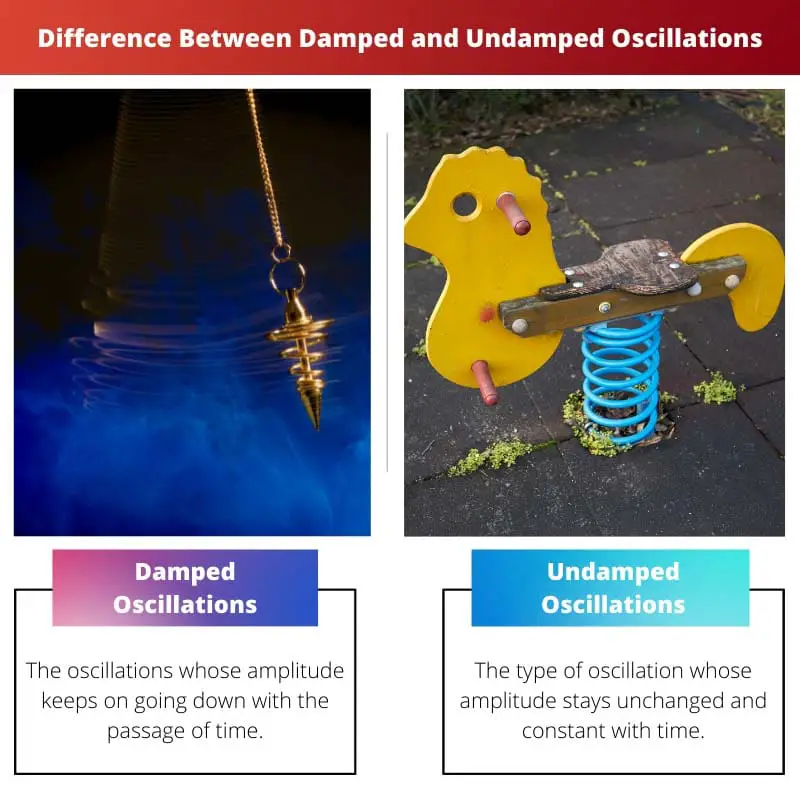It is well proven that each and every object, substance, particle, or system oscillates but within its given frequency. Something on which an object naturally moves, oscillates, or even vibrates is called its frequency.
The frequency of an object works without any external force applied to it. All of these objects and substances require a specific amount of energy to move their oscillation in several HZs to some MHz.
The oscillator fulfils the requirement of energy by the objects. It is a device that is used for generating signals from various sources.
It just produces oscillations on a periodic basis that is generated from a mechanical or electronic form of energy.
Key Takeaways
- Damped oscillations are characterized by a gradual decrease in amplitude over time due to energy dissipation, while undamped oscillations maintain constant amplitude.
- Damped oscillations are commonly found in systems with friction or other forms of damping, while undamped oscillations are found in idealized systems with no damping.
- Damped oscillations can eventually come to a complete stop, while undamped oscillations can continue indefinitely.
Damped vs Undamped Oscillations
The difference between damped and undamped oscillations is that the amplitude of the waves that are being generated keeps on decreasing gradually in damped oscillations, while in undamped oscillations, the amplitude of the waves that are being generated remains unchanged and constant over time. The requirement of energy by the objects is fulfilled by the oscillator. It is a device that is used for generating signals from various sources. It just produces oscillations on a periodic basis that is generated from a mechanical or electronic form of energy.

Damped oscillations are those electrical oscillations whose amplitude decreases continuously because of the losses inherited in the electrical system of power. It is a type of oscillation that fades away with time.
The energy thus produced is gradually decreased proportionate, and this is equal to the square of the amplitude previously calculated. And thus, the damped oscillations are produced by circuits of the oscillator.
If the losses can be compensated for that have occurred in the electrical system, the amplitude of the oscillations happening at that time has remained constant and unchanged.
This form of oscillation is called undamped oscillation. In simpler words, it can be defined as the oscillations that are remained constant with time are the undamped oscillations.
Comparison Table
| Parameters of comparison | Damped Oscillations | Undamped Oscillations |
|---|---|---|
| Meaning | The oscillations whose amplitude keeps on going down with the passage of time. | The type of oscillation whose amplitude stays unchanged and constant with time. |
| Power losses | These oscillations do not stay for a longer time as they keep on decreasing. | There are no power losses in this form of oscillation. |
| Frequency | The frequency remains the same. | The amplitude does not change over time. |
| Period | The damped oscillation eventually dies. | The undamped ones remain the same. |
| Example | Swinging the pendulum, the vibration gradually slows down, and it stops after some time. | A kid’s spring horse or a toy. |
What are Damped Oscillations?
The oscillations whose amplitude keeps decreasing continuously because of the losses inherited in the electrical system of power are called damped oscillations. It is basically a type of oscillation that fades away with time.
The energy thus produced gradually lowers its proportionate, equal to the amplitude’s square. And thus, the damped oscillations are produced by circuits of the oscillator.
The frequency of the oscillation stays unchanged. This is because the frequency depends on the parameters of the circuit.
An example of a pendulum can understand the concept of damped oscillation, a pendulum gradually slows down, and at a point in time, it stops moving.
So, it can be said that wherever there is a loss of energy, the motion is damped, and hence the oscillation is damped.
The damping of an oscillation is caused by the dissipation of the stored energy, which is a gradual decrease in the amplitude of the oscillation.
In the usual cases, mostly all the oscillations are either more or less damped in their amplitude, making compensating for the energy compulsory.
What are Undamped Oscillations?
Undamped oscillations are produced when the losses that are occurred in the electrical system can be compensated, so the amplitude of the oscillations happening at that time remains constant and unchanged.
In simpler words, it can be defined as the oscillations that are remained unchanged along with the time are the undamped oscillations.
The main fact about undamped oscillations is that there are no power losses if the oscillator issues such oscillations.
In the reverse of damped oscillations, if the oscillations that are being produced are undamped, there will be no power loss, and thus there will be no need to compensate for the energy or any loss caused by it.
While in the damped oscillations, most of the energy requires compensation because of the loss of power.
Main Differences Between Damped and Undamped Oscillations
- The main difference between damped and undamped oscillations is that the oscillations whose amplitude keeps on going down with the passage of time are damped oscillations, while the type of oscillation whose amplitude stays unchanged and constant with time are undamped oscillations.
- The amplitude generated through the waves in damped ones keeps decreasing gradually, so these oscillations do not continue for a long time and cease at a certain point. While in there is no loss of power in the oscillation that produces an undamped oscillation.
- The frequency in damped oscillation remains the same, while in undamped ones, the amplitude does not change over time.
- The damped oscillation eventually dies, but the undamped ones remain the same.
- An example of a damped oscillation is a pendulum that is swinging at a constant pace, the vibration gradually slows down, and it stops after some time. An example of undamped oscillation is a kid’s spring horse or a toy.

- https://journals.aps.org/prb/abstract/10.1103/PhysRevB.66.184201
- https://ui.adsabs.harvard.edu/abs/1981oxny.book…..H/abstract
- https://pubs.acs.org/doi/pdf/10.1021/ja01453a010

The section on undamped oscillations and how power losses are compensated to maintain constant amplitude was very well-written.
The examples provided to illustrate damped and undamped oscillations were effective in clarifying the concepts.
The concept of oscillations and the role of the oscillator in generating signals is well-explained in this article.
The comparison table is particularly helpful in understanding the distinctions between damped and undamped oscillations.
The explanation of energy dissipation and its role in damped oscillations was very insightful.
It’s interesting to note how damped oscillations fade away over time while undamped oscillations remain constant.
The discussion of how undamped oscillations remain constant over time and the role of an oscillator in producing them was very educational.
The explanation of how damped oscillations are produced by circuits of the oscillator was especially illuminating.
This article provides a comprehensive overview of the topic of oscillations and is beneficial for acquiring a deeper understanding of the subject.
This was a very informative article about the concept of oscillations and the differences between damped and undamped oscillations.
I agree, this article was very thorough in explaining the principles behind these types of oscillations.